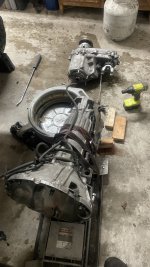I’d only go to a rubicon case if I found one for a good deal AND I could replace the yoke on it. I’m 1350 at the transfer case and a rubicon case is 1310. It MIGHT be the same spline count front and rear as my current case, but if it isn’t then I’m stuck with 1310 joints at the case where probably most of the torque will be applied. Yes it creates an easily repairable weak point. I just don’t think 40s and 1 tons are what the engineers had in mind when going 1310 on the yokes.
Edit: there is also the problem of my speedometer gear no longer working, and the shift linking needing to be replaced. The 241OR shift pattern is the opposite of the 231. Novak sells a shift conversion kit for about $180, and I think a few companies make 1350 holes ( Adams driveshaft) I could used since the rear is a 32 spline. But again it’s just ‘a couple hundred bucks’ for each part added to the cost of a 241OR just to get it to work.




 . Yeah I have all chevy stuff.
. Yeah I have all chevy stuff.